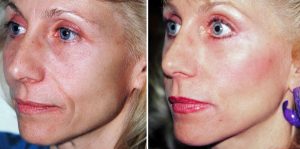Lifting of aging and sagging facial tissues is often perceived as a facelift. In reality, a traditional facelift only affects the lower third of the face…the neck and jowls. That leaves out the two other major facial areas which can be lifted, the forehead (brows) and cheeks. Browlifts are well known and very effective facial rejuvenation procedures whose numerous techniques and methods are well established. Browlifts are often done in combination with a facelift. The cheek area, while aging as much as the brows and the neck, does not have a simple and consistently effective surgical lifting procedure.
Cheek lifts, also known as midface lifts, are intended to lift sagging tissues that were once on top of the cheeks. When the soft tissue falls off of the bony cheek due to loosening of its ligamentous attachments to the skin, it creates what are known as malar festoons. These are bags or bunching of tissue that often creates a ‘double bubble’ look to the midface. Or the midface can look like wax melting off of candle. Most people think that a facelift or a browlift will somehow correct this cheek sagging but it will not.

An alternative and less problematic approach is that of the temporal cheek lift. The incision is right at the junction of the preauricular and temporal hairline. By placing it here, the hairline will not be shifted upward and the delicate lateral eyelid area is completely avoided. Skin flaps elevated for about an inch or inch and a half downward so that its pull lifts the cheek tissues. This is then combined with the use of barbed sutures or threads which are inserted underneath the skin flaps. They are directly toward the sagging cheeks and then tied together to further lift the cheeks. The combination of the skin pull and the barbed sutures creates a very nice cheek tuck-up. The excess raised skin, now lying over the incision is trimmed and closed.
This temporal cheek tuck-up has numerous advantages including ease of execution, lack of any problems in the eye area, and very minimal recovery. It can be performed in the office under local anesthesia. Its disadvantage is that it is not as powerful as the cranially-directed midface lift so patient selection and expectations are critical. I have found it useful for those patients with more mild forms of cheek sagging, after a facelift procedure, and when a conventional midface lift needs further improvement.
Dr. Barry Eppley
Indianapolis, Indiana


